KNOW YOUR
BLACK HISTORY:
PART II
SLAVE REVOLTS
BY SEA:
RELENTLESS
DETERMINATION
AND THE END
OF THE MYTH
OF THE AMISTAD
Slavery’s Middle Passage has been described as the “African Holocaust,” a brutal and deadly voyage for Africans forcibly taken for the slave trade to the Americas. Estimates of how many Africans died on the voyage range as high as 50%. The movement of slaves along the Middle Passage was anything but orderly. Bloody slave revolts broke out on ships bound for the Americas, often making the voyage just as perilous for the slavers transporting slaves across the Atlantic.
To understand how much of America’s wealth was generated by slavery; we need look no further than the Atlantic slave trade. Massachusetts, Rhode Island, Connecticut and New York were not known as slave states. Yet their maritime industry and industries that supported the maritime infrastructure, reaped huge profits from slave transport. Maritime law favored slavers, allowing ship-owners to file insurance claims and receive compensation for slaves that were killed during the voyages. Aetna Insurance Company, headquartered in Hartford, Conn., profited from selling insurance policies on slaves in the U.S. during the 1800s.
Slave revolts at sea were essential in stemming increased slavery in the Americas. Historian Joseph E. Holloway has made the following estimates. Between 1500 and 1859, ten to 15 million were transported to the Americas along the Middle Passage; 10% to 50% of them died en route. Of those who died at sea, one in 15 died in an attempted revolt. According to these figures, the bloody toll of slave revolts at sea kept 660,000 to 1,000,000 Africans from entering the bonds of slavery on land in the Americas.
By Nick Douglas, AFROPUNK Contributor
In all about 500,000 slaves were transported to the U.S. Nearly half of American slaves were transported here illegally after the U.S. government outlawed the importation of slaves in 1808. This legislation was prompted partially by fear that the U.S. might experience a slave rebellion similar to the Haitian Revolution if they continued to take new African slaves. But due to lax government enforcement, as late as 1859 in America’s large port cities there were still ships being outfitted to transport slaves.
The Caribbean, Mexico, Central America and Latin America received the lion’s share of the slaves during the Atlantic slave trade—ten to 14 million. These areas also had the largest number of revolts on ship and on land. The majority of the 500 reported slave revolts at sea occurred on slave ships bound for Latin America. Slavery was abolished in Haiti in 1804. By 1829, due to campaigns of liberation by Simon Bolivar, slavery was abolished in every country on Latin America except Brazil, which was under Portuguese control.
There were more than 500 reported revolts aboard slave ships during the Atlantic slave trade. It is likely that hundreds and even thousands more revolts took place that were never reported. During the 300 years of the slave trade, 145 vessels sank with all aboard perishing. Fifteen hundred ships were never accounted for. We will never know how many of these vessels were taken over during revolts. We do not have an accurate accounting of how many slaves forced slave ships to leave them ashore, often with guns and supplies, in the Americas or back in Africa. Known as maroons, they often killed the crews and burned the ships after their escape.
Slavers developed a variety of tactics to lower the chances of slave revolts. They hired heavily armed crews. They took slaves from many different tribes, to prevent them from communicating with each other during the voyage. They kept slaves confined below deck for the whole voyage and even installed more portholes below decks to allow slaves more fresh air, rather than risk having them come on the main deck. Nothing they came up with stopped slave revolts at sea.
Most revolts were unsuccessful, but the attempts took a huge death toll on slave crews and the Africans who rebelled. Slave revolts at sea were unique situation for both slavers and slaves. Heavily armed crews literally had to fight for their lives if the vessel was a long way from land. They could not escape. Revolts that happened at anchor or near shore were usually their only opportunity to escape in boats or jump overboard and swim for shore, which many did. Slave revolts that happened in the open ocean were also the most dangerous for slaves. They needed to either know how to navigate the vessel safely back to shore, or risk capturing sailors who had the knowledge to sail the vessel safely to port. This was the case with the revolt aboard the Amistad; the slaves had to make sure that they captured sailors who could navigate the ship safely to land. In the case of the Amistad the sailors tricked the slaves and did not return them to Africa but navigated to the Americas. Slave revolts at sea were literally a life or death struggle, and both slaves and crews were prepared to do anything to prevail.
Many Americans know of only one successful slave revolt at sea, on the ship Amistad. The movie Amistad portrays the white courts and attorneys for the slaves as the heroes who allowed the slaves to return home as free men. This is a palatable story because in the end Africans relied on the goodwill of white Americans for their salvation.
Successful slave revolts were when slaves attained their own freedom without any reliance on outside forces to make determination of their future fortunes. I consider the Amistad a failed revolt. The Amistad story is a continuation of the myth of white, heroic benevolence in the struggle against slavery. African slaves took every opportunity available to them to revolt. It was their fearless attacks upon their heavily armed captors that made the determination if they would go free or not.
Early colonial newspapers reported in detail what happened to slave vessels from their ports. Colonists read of constant slave revolts occurring along the Middle Passage. Hundreds of slave revolts were reported aboard slave ships originating from the American colonies. This article will highlight only a few.
Many slave vessels were attacked in Africa before even leaving the continent. On January 23, 1731, the Read’s Weekly Journal reported that the captain and entire crew of the Boston schooner William Jump were “surprised by their slaves on the Coast” and were killed, except for three boys.
A report in the Oct. 25, 1732 Rhode Island Gazette gives an idea of the chaos and ferocity of slave revolts and how quickly they happened. Four “Negro Traders” who boarded a vessel off the coast of Guinea were assumed to have instigated and assisted an uprising in which about 20 slaves escaped in boats and canoes with the traders. Later, more Africans came back in canoes and attempted to re-board the ship to free the remaining slaves but were “beat-off.” At the same time on a nearby ship, slaves rose up and destroyed the whole crew, including Captain Perkins, whose head, legs and arms were cut off.
In 1742 in Sierra Leone the vessel the Jolly Batchelor was attacked by Africans from shore who freed all the slaves on board.
News of slave revolts could take months to arrive. The death of Captain Bear from Rhode Island off the coast of Guinea in January 1747 was reported in the Pennsylvania Gazette in May. Captain Bear and his crew were killed by slaves on their vessel with a considerable amount of gold on board. The only two survivors jumped overboard and swam to safety, then sent their account by letter via Barbados. The vessel probably like many of those never accounted for was taken over in the slave revolt. It would be logical to assume that along with their freedom, the slaves took the gold with them.
The June 1763 Newport Mercury describes slave revolts involving two slavers from Newport, RI. A Captain Taylor, arriving from Annamaboa, present-day Ghana, reported that two slave traders from Newport had been killed in November 1762 in present day Gabon Estuary. Captain George Frost from Newport let 60 slaves on deck, and they seized him and threw him overboard, along with a black sailor. The black sailor was able to swim to shore. The captain tried to swim back to the vessel, where the Africans impaled him with a lance. The Africans used the small arms aboard to fire at canoes they saw approaching the vessel and unintentionally set off an explosion of gunpowder on board that killed about 30 slaves. Three days later when the vessel was re-boarded, the mate, Mr. Grant, also from Newport, was found below deck with his throat cut.
Captain Taylor reported another slave vessel (out of Liverpool, England) taken over by Africans, who killed the mate. The slaves escaped, leaving the vessel to run ashore and be wrecked by the surf.
In 1765 a mate named Dunfield arrived in Newport, RI on a sloop called the Three Friends. He had been a mate on a slave schooner out of Bristol, Conn. In the winter of 1764 every crewman and the captain killed by slaves near Sierra Leone. He was spared because he had luckily been off the boat at the time of the rebellion.
In the Nov. 25, 1765 edition of Boston-Post Boy and Advertiser, two captains reported what had happened on their slave vessels. Captain Hopkins of a brig out of Providence, Rhode Island reported that soon after his ship left the coast of Africa, his crew became sick. He had to bring slaves “on deck” to assist in running the ship. The slaves managed to free all the slaves below and in a bloody battle he and his crew killed, wounded or forced overboard 80 slaves to regain control of the brig. Captain Rogers, who had left Africa bound for the West Indies, killed 12 slaves after the slaves were able to free themselves and attempted to take over his vessel near Barbados.
These few examples taken from hundreds of reported shipboard revolts show that African slaves took every opportunity available to them to revolt. Africans entered into a life or death struggle to prevent themselves from being taken from Africa to be enslaved in the Americas. They did not rely on the court system or white benevolence to determine their rights to freedom. Their fearless attempts against heavily-armed slave crews show a relentless determination to resist slavery. Their determination to resist enslavement did not end after the Middle Passage it continued on land once they landed in the Americas. I will describe these in the second part of “Slave Revolts by Land and Sea.”
++++++++++++
Nick Douglas is the author of Finding Octave: The Untold Story of Two Creole Families and Slavery in Louisiana, which is available on amazon.com. He has a contact blog www.findingoctave.com/contact.html for readers who may want to contact him.
Much of the information for this article and information about other slave revolts is available on www.slaverebellion.org.


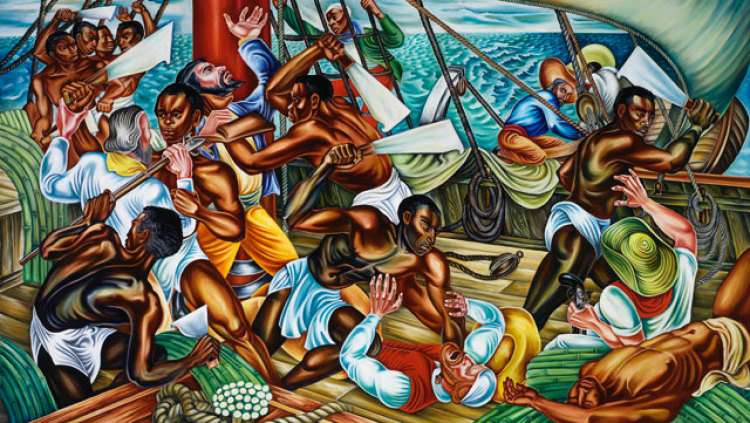
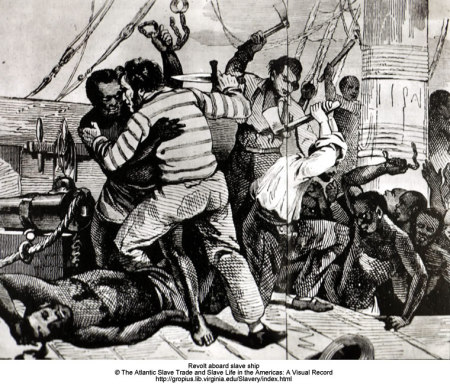
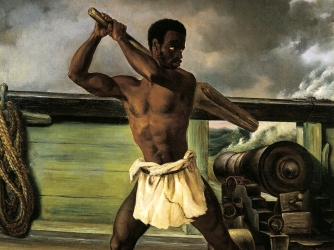
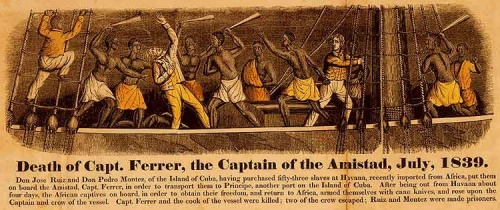
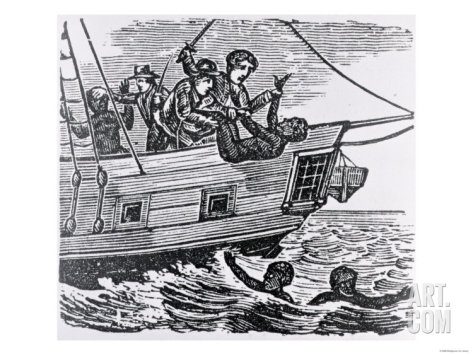

What an amazing story about courage, revolt, perseverance and hope…